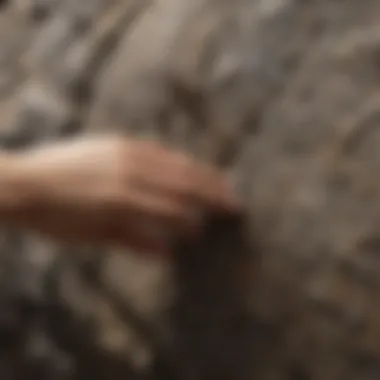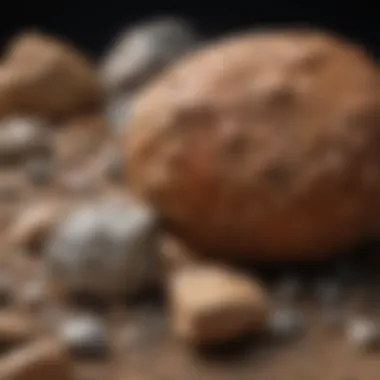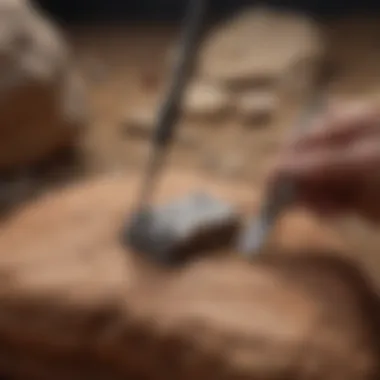Unveiling Rock Hardness Evaluation Techniques for Enthusiastic Collectors


Rock and Fossil Identification
Rock and fossil identification are core aspects of rock hardness testing for enthusiastic collectors. Understanding the types of rocks and fossils is fundamental in this pursuit. Enthusiasts need to familiarize themselves with the characteristics to look for when identifying different rocks and fossils. Utilizing specialized tools for identification, such as magnifying glasses and hardness testing kits, enhances the accuracy of assessments.
Collecting Tips and Techniques
Moving beyond identification, collectors must adhere to best practices when collecting rocks and fossils. Locating prime collecting sites is crucial for finding rare specimens. Enthusiasts should learn how to safely extract specimens without causing damage to the surrounding environment or the specimens themselves.
Preservation and Display
Preservation plays a vital role in ensuring the longevity of collected rocks and fossils. Techniques such as cleaning, stabilizing, and storing specimens correctly are essential. Proper storage methods, including using acid-free materials and temperature-controlled environments, prevent deterioration. Creative display ideas help enthusiasts showcase their collections while maintaining the specimens' integrity.
Geological Insights
Delving deeper into the world of rock hardness testing reveals fascinating geological insights. Understanding various geological formations and processes provides context for the hardness of different rocks and fossils. Exploring the historical significance of certain specimens adds a layer of richness to collectors' experiences. Notable discoveries in the field offer insights into groundbreaking findings and further ignite enthusiasts' passion for rock and fossil collection.
Introduction
In the fascinating world of rock and mineral collection, the assessment of rock hardness holds paramount importance. Rock hardness testing methods serve as a cornerstone for enthusiasts, providing vital insights into the composition and durability of collected specimens. This article aims to delve deep into the intricate science of rock hardness assessment, offering a comprehensive guide for enthusiastic collectors looking to enhance their understanding of this essential aspect of their hobby.
Understanding Rock Hardness
The Significance of Rock Hardness in Collecting
The Significance of Rock Hardness in collecting plays a crucial role in determining the quality and durability of rocks and minerals acquired by collectors. Understanding the hardness of a specimen not only aids in identification but also provides valuable information on its resistance to wear and tear. Enthusiasts rely on rock hardness to differentiate between various minerals and categorize them effectively within their collections. This section delves into the key characteristic of rock hardness in collecting, shedding light on its significance and the unmatched value it offers to collectors. Exploring this aspect gives collectors a solid foundation for making informed decisions and enriching their collecting experience.
The Science Behind Rock Hardness
The Science Behind Rock Hardness provides collectors with a deeper understanding of the underlying principles that govern rock hardness testing methods. Through scientific insights, enthusiasts gain a nuanced perspective on how different minerals exhibit varying levels of hardness. Understanding the science behind rock hardness not only enhances collectors' ability to assess specimens accurately but also cultivates a true appreciation for the geological processes that shape these rocks. This section unveils the unique features of the science behind rock hardness, offering a detailed exploration of its advantages and potential limitations in the context of rock and mineral collecting.


Purpose of Rock Hardness Testing
Identifying Mineral Composition
Identifying Mineral Composition through rock hardness testing serves as a fundamental step in the evaluation of geological specimens. By assessing the hardness of a mineral, collectors can ascertain its mineral composition based on established hardness characteristics. This aspect of rock hardness testing is instrumental in helping enthusiasts differentiate between similar-looking minerals and validate the authenticity of their findings. The ability to identify mineral composition through hardness testing empowers collectors to build more robust and accurate geological collections. Exploring this aspect reveals the unique features of identifying mineral composition and its implications for collectors.
Assessing Wear Resistance
Assessing Wear Resistance is a vital component of rock hardness testing methods, offering collectors valuable insights into the durability and longevity of their specimens. Understanding the wear resistance of rocks and minerals helps enthusiasts gauge how well a specimen will retain its aesthetic appeal over time. By evaluating wear resistance through hardness testing, collectors can make informed decisions regarding the display and preservation of their collections. This section delves into the key characteristic of assessing wear resistance, highlighting its importance and implications within the realm of rock and mineral collecting.
Methods of Rock Hardness Testing
When delving into the realm of rock hardness assessment, the Methods of Rock Hardness Testing stand as a pivotal component, offering enthusiasts a range of tools to evaluate the hardness of rocks and minerals with precision and accuracy. These methods play a crucial role in aiding collectors in determining the durability, wear resistance, and mineral composition of their specimens. Through techniques such as scratch tests, the Mohs scale, Vickers Hardness Test, and Brinell Hardness Test, collectors can gain valuable insights into the physical properties of their rock samples.
Scratch Tests
Principles of Scratch Testing
The Principles of Scratch Testing serve as a foundational method for assessing the hardness of rocks by observing the materials' resistance to scratches under specific conditions. This technique involves using a harder material to scratch a sample to determine its relative hardness. It provides collectors with a practical and straightforward way to gauge the hardness of various minerals, aiding in identification and classification. However, one must consider the limitations of scratch testing, such as subjective interpretation of scratch depth and the potential for sample damage during testing.
Interpreting Results
Interpreting results from scratch tests plays a crucial role in determining the relative hardness of rocks and minerals. By analyzing the depth and characteristics of scratches left on the sample surface, collectors can draw conclusions about the specimen's hardness level. This analytical process allows enthusiasts to make informed decisions regarding their mineral collections, guiding them in sorting and classifying rocks based on their hardness properties. While scratch testing offers a quick and accessible method for assessing hardness, collectors must exercise precision and caution to ensure accurate interpretation of results.
Mohs Scale of Hardness
Overview of the Mohs Scale
The Mohs Scale of Hardness provides collectors with a standardized system for comparing the hardness of different minerals relative to one another. Developed by Friedrich Mohs in 1812, this scale ranks minerals from 1 (softest) to 10 (hardest), based on their resistance to scratching. By understanding the Mohs Scale, enthusiasts can classify and identify minerals based on their hardness, aiding in the evaluation and categorization of geological specimens. While the Mohs Scale offers a convenient way to compare mineral hardness, it is important to note that the scale is relative and does not provide precise quantitative measurements of hardness.
Comparing Different Minerals


Comparing different minerals using the Mohs Scale allows collectors to differentiate between various rocks and gems based on their relative hardness. By conducting comparative tests using standard materials of known hardness, enthusiasts can assess the scratch resistance of different minerals accurately. This comparative analysis not only facilitates the identification of gemstones but also assists in verifying the authenticity of precious stones. While the Mohs Scale offers a valuable framework for classifying minerals, collectors should be mindful of its qualitative nature and the need for additional quantitative hardness testing for precise assessments.
Vickers Hardness Test
Application in Mineralogy
The Vickers Hardness Test serves as a versatile method for quantifying the hardness of minerals numerically, providing collectors with precise measurements of mineral hardness. In mineralogy, this test offers a reliable way to determine the resistance of rocks to indentation, allowing enthusiasts to assess hardness in a quantitative manner. By employing a pyramidal diamond in the testing process, the Vickers Hardness Test enables collectors to obtain hardness values that aid in mineral classification and analysis. However, it is essential to note that while the Vickers Test offers numerical data on hardness, the complexity of the test apparatus and interpretation may require a certain level of expertise for accurate results.
Measuring Hardness Numerically
Measuring hardness numerically through the Vickers Test enables collectors to assign precise values to the hardness of rocks and minerals, enhancing the accuracy and reliability of hardness assessments. By calculating the size of the indentation left by the diamond pyramid indenter, enthusiasts can determine the hardness of a material based on the applied load and the surface area of the indentation. This numerical approach offers a quantitative dimension to hardness testing, allowing for comprehensive comparisons and analysis of mineral hardness across different samples. While numerical measurements provide detailed insights into mineral hardness, collectors should be aware of the technical considerations involved in conducting Vickers tests to ensure precise and consistent results.
Brinell Hardness Test
Testing Hardness Through Indentation
The Brinell Hardness Test assesses the hardness of rocks by measuring the indentation created by a hardened steel or carbide ball under a specific load. This method allows collectors to quantify the resistance of rocks to deformation, providing valuable data on hardness values. By applying a controlled force to the specimen's surface, enthusiasts can determine the material's hardness based on the size of the resulting indentation. The Brinell Test offers a practical approach to hardness evaluation through indentation testing, enabling collectors to compare and classify rocks based on their relative hardness levels. However, variations in indentation size due to surface imperfections and material properties may influence the precision of hardness measurements.
Calculating Hardness Values
Calculating hardness values using the Brinell Test involves determining the ratio of the applied load to the surface area of the indentation, providing collectors with quantifiable hardness measurements. By conducting precise calculations based on the indentation diameter, enthusiasts can obtain accurate hardness values for different minerals, aiding in mineral classification and analysis. This quantitative approach enhances the objectivity of hardness assessments, allowing collectors to assign numerical values to the hardness of rocks systematically. While calculating hardness values through the Brinell Test offers a robust method for hardness quantification, variations in indentation morphology and testing conditions may introduce factors that require careful consideration for accurate results.
Practical Applications of Rock Hardness Testing
In the realm of rock and mineral collecting, the practical applications of rock hardness testing hold a pivotal role. Enthusiastic collectors delve deep into this aspect to gain crucial insights into the specimens they acquire. By evaluating the hardness of rocks, collectors can determine the durability and resilience of the specimens, providing essential information for further categorization and analysis. Understanding the practical applications of rock hardness testing enables collectors to make informed decisions regarding the care, preservation, and display of their valuable finds.
Sorting and Classifying Rocks
Evaluating Collectible Specimens
Evaluating collectible specimens plays a vital role in the overall process of rock hardness testing. By scrutinizing the physical properties and hardness of individual rocks, collectors can assess the quality and uniqueness of each specimen. This meticulous evaluation aids in categorizing rocks based on their hardness levels, contributing to a more systematic approach to rock collecting. The key characteristic of evaluating collectible specimens lies in its ability to unveil the intrinsic characteristics of rocks, allowing collectors to appreciate the geological complexities and diversity present in their collections. While evaluating collectible specimens enhances the overall experience of rock collecting, it also presents challenges such as subjective interpretation and varying results, adding a layer of complexity to the process.


Organizing Geological Collections
Organizing geological collections is an essential aspect that complements rock hardness testing for enthusiastic collectors. By arranging specimens based on their hardness levels, mineral composition, and geological significance, collectors can create a cohesive collection that showcases a wide spectrum of rocks and minerals. The key characteristic of organizing geological collections lies in its ability to provide a structured framework for cataloging and displaying specimens, enhancing both the aesthetic appeal and educational value of the collection. This methodical approach not only facilitates easy retrieval and referencing of specimens but also enables collectors to track the provenance and unique attributes of each rock or mineral. While organizing geological collections offers numerous benefits in terms of visual presentation and research facilitation, it requires meticulous planning and upkeep to maintain the integrity and coherence of the collection.
Identifying Gemstones
Distinguishing Precious Stones
Distinguishing precious stones holds significant importance in the context of rock hardness testing for collectors. By adeptly recognizing the distinct characteristics and hardness levels of gemstones, collectors can accurately identify and appreciate the value of these coveted specimens. The key characteristic of distinguishing precious stones lies in its ability to discern the unique features and brilliance of gemstones, allowing collectors to differentiate between various types of precious stones based on their hardness and refractive properties. This skill not only adds value to a collector's repertoire but also serves as a distinguishing factor in verifying the authenticity and rarity of gemstones. While distinguishing precious stones enhances the overall experience of gemstone collection, it requires knowledge, practice, and attention to detail to master the art of gemstone identification.
Verifying Authenticity
Verifying the authenticity of gemstones is a crucial step in the rock hardness testing process for collectors. By employing scientific methods such as hardness testing and visual examination, collectors can validate the genuineness and quality of gemstones in their collection. The key characteristic of verifying authenticity lies in its ability to ensure the credibility and value of gemstones, safeguarding collectors against counterfeit or synthetic specimens. This meticulous process not only enhances the integrity of a collection but also establishes trust and reputation within the collecting community. While verifying authenticity instills confidence and credibility in a collector's acquisitions, it requires expertise, precision, and access to specialized equipment to accurately assess the authenticity and quality of gemstones.
Challenges and Considerations
In the realm of rock hardness testing methods for enthusiastic collectors, acknowledging and understanding the challenges and considerations associated with this practice is paramount. These factors not only shape the accuracy of test results but also influence various aspects of rock and mineral assessment. By delving into these challenges and considerations, collectors can navigate the complexities of rock hardness testing with greater proficiency.
Subjectivity in Testing
Impact of Tester Experience
The impact of tester experience plays a crucial role in the reliability and credibility of rock hardness testing results. Experienced testers bring a nuanced understanding of subtle distinctions in hardness levels, enabling them to make more accurate assessments. Their wealth of knowledge allows them to overcome potential biases or misinterpretations that less-experienced individuals may encounter. The ability to discern minor differences in hardness can be the differentiating factor in accurately categorizing rocks and minerals. Therefore, leveraging the expertise of seasoned testers enhances the overall quality and precision of hardness evaluations in the context of enthusiastic collectors seeking precise measurements to enrich their collections.
Factors Influencing Results
Analyzing the various factors that influence testing results sheds light on the multifaceted nature of rock hardness assessment. Factors such as environmental conditions, composition variations, and testing methodologies can significantly impact the outcomes of hardness tests. Understanding these influences enables collectors to interpret results more effectively and adjust their testing approaches accordingly. By acknowledging the diverse factors that can sway hardness measurements, enthusiasts can adopt a more comprehensive and holistic view of rock hardness evaluation. This insight not only refines the accuracy of assessments but also fosters a deeper appreciation for the intricate interplay of variables within the realm of rock hardness testing.
Environmental Factors
Temperature and Humidity Effects
Temperature and humidity effects exert a notable influence on rock hardness testing, presenting collectors with unique challenges and considerations. Fluctuations in temperature and moisture levels can alter the hardness properties of rocks and minerals, potentially leading to skewed test results. By comprehensively understanding how these environmental variables interact with the specimens being tested, collectors can account for such effects and mitigate their impact on hardness evaluations. Balancing the environmental conditions during testing procedures is essential for ensuring the consistency and accuracy of hardness measurements, allowing enthusiasts to obtain reliable data for their collections.
Contamination Risks
Navigating the landscape of contamination risks is crucial for conducting reliable and precise rock hardness tests. Contaminants present in the testing environment can affect the hardness properties of specimens, confounding the authenticity of test results. Identifying and mitigating contamination risks require meticulous attention to detail and adherence to rigorous testing protocols. By proactively addressing potential sources of contamination and maintaining a controlled testing environment, collectors can minimize inaccuracies and distortions in hardness measurements. Effectively managing contamination risks enhances the credibility and integrity of hardness testing outcomes, enabling enthusiasts to make informed decisions regarding their prized rock and mineral collections.







